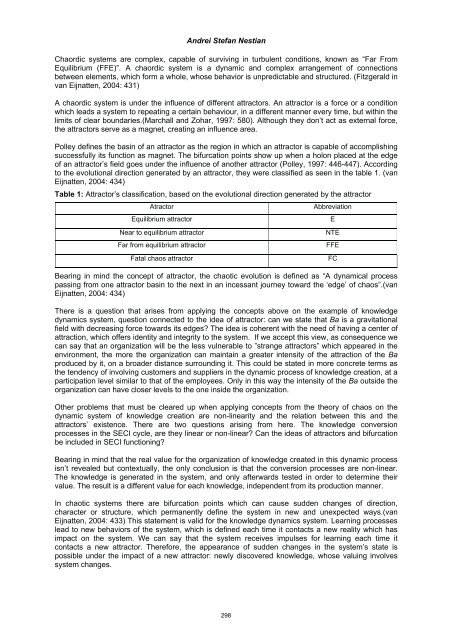Proceedings of the 3rd European Conference on Intellectual Capital
Proceedings of the 3rd European Conference on Intellectual Capital
Proceedings of the 3rd European Conference on Intellectual Capital
You also want an ePaper? Increase the reach of your titles
YUMPU automatically turns print PDFs into web optimized ePapers that Google loves.
Andrei Stefan Nestian<br />
Chaordic systems are complex, capable <str<strong>on</strong>g>of</str<strong>on</strong>g> surviving in turbulent c<strong>on</strong>diti<strong>on</strong>s, known as “Far From<br />
Equilibrium (FFE)”. A chaordic system is a dynamic and complex arrangement <str<strong>on</strong>g>of</str<strong>on</strong>g> c<strong>on</strong>necti<strong>on</strong>s<br />
between elements, which form a whole, whose behavior is unpredictable and structured. (Fitzgerald in<br />
van Eijnatten, 2004: 431)<br />
A chaordic system is under <str<strong>on</strong>g>the</str<strong>on</strong>g> influence <str<strong>on</strong>g>of</str<strong>on</strong>g> different attractors. An attractor is a force or a c<strong>on</strong>diti<strong>on</strong><br />
which leads a system to repeating a certain behaviour, in a different manner every time, but within <str<strong>on</strong>g>the</str<strong>on</strong>g><br />
limits <str<strong>on</strong>g>of</str<strong>on</strong>g> clear boundaries.(Marchall and Zohar, 1997: 580). Although <str<strong>on</strong>g>the</str<strong>on</strong>g>y d<strong>on</strong>’t act as external force,<br />
<str<strong>on</strong>g>the</str<strong>on</strong>g> attractors serve as a magnet, creating an influence area.<br />
Polley defines <str<strong>on</strong>g>the</str<strong>on</strong>g> basin <str<strong>on</strong>g>of</str<strong>on</strong>g> an attractor as <str<strong>on</strong>g>the</str<strong>on</strong>g> regi<strong>on</strong> in which an attractor is capable <str<strong>on</strong>g>of</str<strong>on</strong>g> accomplishing<br />
successfully its functi<strong>on</strong> as magnet. The bifurcati<strong>on</strong> points show up when a hol<strong>on</strong> placed at <str<strong>on</strong>g>the</str<strong>on</strong>g> edge<br />
<str<strong>on</strong>g>of</str<strong>on</strong>g> an attractor’s field goes under <str<strong>on</strong>g>the</str<strong>on</strong>g> influence <str<strong>on</strong>g>of</str<strong>on</strong>g> ano<str<strong>on</strong>g>the</str<strong>on</strong>g>r attractor (Polley, 1997: 446-447). According<br />
to <str<strong>on</strong>g>the</str<strong>on</strong>g> evoluti<strong>on</strong>al directi<strong>on</strong> generated by an attractor, <str<strong>on</strong>g>the</str<strong>on</strong>g>y were classified as seen in <str<strong>on</strong>g>the</str<strong>on</strong>g> table 1. (van<br />
Eijnatten, 2004: 434)<br />
Table 1: Attractor’s classificati<strong>on</strong>, based <strong>on</strong> <str<strong>on</strong>g>the</str<strong>on</strong>g> evoluti<strong>on</strong>al directi<strong>on</strong> generated by <str<strong>on</strong>g>the</str<strong>on</strong>g> attractor<br />
Atractor Abbreviati<strong>on</strong><br />
Equilibrium attractor E<br />
Near to equilibrium attractor NTE<br />
Far from equilibrium attractor FFE<br />
Fatal chaos attractor FC<br />
Bearing in mind <str<strong>on</strong>g>the</str<strong>on</strong>g> c<strong>on</strong>cept <str<strong>on</strong>g>of</str<strong>on</strong>g> attractor, <str<strong>on</strong>g>the</str<strong>on</strong>g> chaotic evoluti<strong>on</strong> is defined as “A dynamical process<br />
passing from <strong>on</strong>e attractor basin to <str<strong>on</strong>g>the</str<strong>on</strong>g> next in an incessant journey toward <str<strong>on</strong>g>the</str<strong>on</strong>g> ‘edge’ <str<strong>on</strong>g>of</str<strong>on</strong>g> chaos”.(van<br />
Eijnatten, 2004: 434)<br />
There is a questi<strong>on</strong> that arises from applying <str<strong>on</strong>g>the</str<strong>on</strong>g> c<strong>on</strong>cepts above <strong>on</strong> <str<strong>on</strong>g>the</str<strong>on</strong>g> example <str<strong>on</strong>g>of</str<strong>on</strong>g> knowledge<br />
dynamics system, questi<strong>on</strong> c<strong>on</strong>nected to <str<strong>on</strong>g>the</str<strong>on</strong>g> idea <str<strong>on</strong>g>of</str<strong>on</strong>g> attractor: can we state that Ba is a gravitati<strong>on</strong>al<br />
field with decreasing force towards its edges? The idea is coherent with <str<strong>on</strong>g>the</str<strong>on</strong>g> need <str<strong>on</strong>g>of</str<strong>on</strong>g> having a center <str<strong>on</strong>g>of</str<strong>on</strong>g><br />
attracti<strong>on</strong>, which <str<strong>on</strong>g>of</str<strong>on</strong>g>fers identity and integrity to <str<strong>on</strong>g>the</str<strong>on</strong>g> system. If we accept this view, as c<strong>on</strong>sequence we<br />
can say that an organizati<strong>on</strong> will be <str<strong>on</strong>g>the</str<strong>on</strong>g> less vulnerable to ”strange attractors” which appeared in <str<strong>on</strong>g>the</str<strong>on</strong>g><br />
envir<strong>on</strong>ment, <str<strong>on</strong>g>the</str<strong>on</strong>g> more <str<strong>on</strong>g>the</str<strong>on</strong>g> organizati<strong>on</strong> can maintain a greater intensity <str<strong>on</strong>g>of</str<strong>on</strong>g> <str<strong>on</strong>g>the</str<strong>on</strong>g> attracti<strong>on</strong> <str<strong>on</strong>g>of</str<strong>on</strong>g> <str<strong>on</strong>g>the</str<strong>on</strong>g> Ba<br />
produced by it, <strong>on</strong> a broader distance surrounding it. This could be stated in more c<strong>on</strong>crete terms as<br />
<str<strong>on</strong>g>the</str<strong>on</strong>g> tendency <str<strong>on</strong>g>of</str<strong>on</strong>g> involving customers and suppliers in <str<strong>on</strong>g>the</str<strong>on</strong>g> dynamic process <str<strong>on</strong>g>of</str<strong>on</strong>g> knowledge creati<strong>on</strong>, at a<br />
participati<strong>on</strong> level similar to that <str<strong>on</strong>g>of</str<strong>on</strong>g> <str<strong>on</strong>g>the</str<strong>on</strong>g> employees. Only in this way <str<strong>on</strong>g>the</str<strong>on</strong>g> intensity <str<strong>on</strong>g>of</str<strong>on</strong>g> <str<strong>on</strong>g>the</str<strong>on</strong>g> Ba outside <str<strong>on</strong>g>the</str<strong>on</strong>g><br />
organizati<strong>on</strong> can have closer levels to <str<strong>on</strong>g>the</str<strong>on</strong>g> <strong>on</strong>e inside <str<strong>on</strong>g>the</str<strong>on</strong>g> organizati<strong>on</strong>.<br />
O<str<strong>on</strong>g>the</str<strong>on</strong>g>r problems that must be cleared up when applying c<strong>on</strong>cepts from <str<strong>on</strong>g>the</str<strong>on</strong>g> <str<strong>on</strong>g>the</str<strong>on</strong>g>ory <str<strong>on</strong>g>of</str<strong>on</strong>g> chaos <strong>on</strong> <str<strong>on</strong>g>the</str<strong>on</strong>g><br />
dynamic system <str<strong>on</strong>g>of</str<strong>on</strong>g> knowledge creati<strong>on</strong> are n<strong>on</strong>-linearity and <str<strong>on</strong>g>the</str<strong>on</strong>g> relati<strong>on</strong> between this and <str<strong>on</strong>g>the</str<strong>on</strong>g><br />
attractors’ existence. There are two questi<strong>on</strong>s arising from here. The knowledge c<strong>on</strong>versi<strong>on</strong><br />
processes in <str<strong>on</strong>g>the</str<strong>on</strong>g> SECI cycle, are <str<strong>on</strong>g>the</str<strong>on</strong>g>y linear or n<strong>on</strong>-linear? Can <str<strong>on</strong>g>the</str<strong>on</strong>g> ideas <str<strong>on</strong>g>of</str<strong>on</strong>g> attractors and bifurcati<strong>on</strong><br />
be included in SECI functi<strong>on</strong>ing?<br />
Bearing in mind that <str<strong>on</strong>g>the</str<strong>on</strong>g> real value for <str<strong>on</strong>g>the</str<strong>on</strong>g> organizati<strong>on</strong> <str<strong>on</strong>g>of</str<strong>on</strong>g> knowledge created in this dynamic process<br />
isn’t revealed but c<strong>on</strong>textually, <str<strong>on</strong>g>the</str<strong>on</strong>g> <strong>on</strong>ly c<strong>on</strong>clusi<strong>on</strong> is that <str<strong>on</strong>g>the</str<strong>on</strong>g> c<strong>on</strong>versi<strong>on</strong> processes are n<strong>on</strong>-linear.<br />
The knowledge is generated in <str<strong>on</strong>g>the</str<strong>on</strong>g> system, and <strong>on</strong>ly afterwards tested in order to determine <str<strong>on</strong>g>the</str<strong>on</strong>g>ir<br />
value. The result is a different value for each knowledge, independent from its producti<strong>on</strong> manner.<br />
In chaotic systems <str<strong>on</strong>g>the</str<strong>on</strong>g>re are bifurcati<strong>on</strong> points which can cause sudden changes <str<strong>on</strong>g>of</str<strong>on</strong>g> directi<strong>on</strong>,<br />
character or structure, which permanently define <str<strong>on</strong>g>the</str<strong>on</strong>g> system in new and unexpected ways.(van<br />
Eijnatten, 2004: 433) This statement is valid for <str<strong>on</strong>g>the</str<strong>on</strong>g> knowledge dynamics system. Learning processes<br />
lead to new behaviors <str<strong>on</strong>g>of</str<strong>on</strong>g> <str<strong>on</strong>g>the</str<strong>on</strong>g> system, which is defined each time it c<strong>on</strong>tacts a new reality which has<br />
impact <strong>on</strong> <str<strong>on</strong>g>the</str<strong>on</strong>g> system. We can say that <str<strong>on</strong>g>the</str<strong>on</strong>g> system receives impulses for learning each time it<br />
c<strong>on</strong>tacts a new attractor. Therefore, <str<strong>on</strong>g>the</str<strong>on</strong>g> appearance <str<strong>on</strong>g>of</str<strong>on</strong>g> sudden changes in <str<strong>on</strong>g>the</str<strong>on</strong>g> system’s state is<br />
possible under <str<strong>on</strong>g>the</str<strong>on</strong>g> impact <str<strong>on</strong>g>of</str<strong>on</strong>g> a new attractor: newly discovered knowledge, whose valuing involves<br />
system changes.<br />
298
















